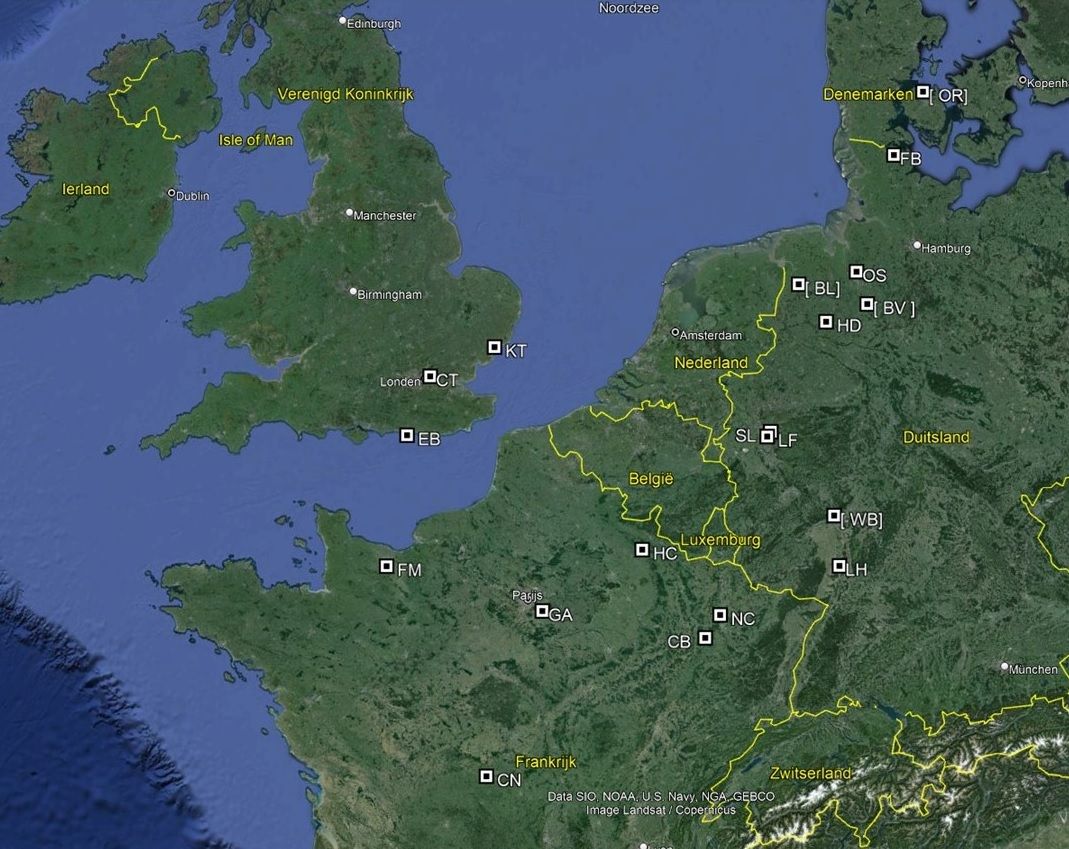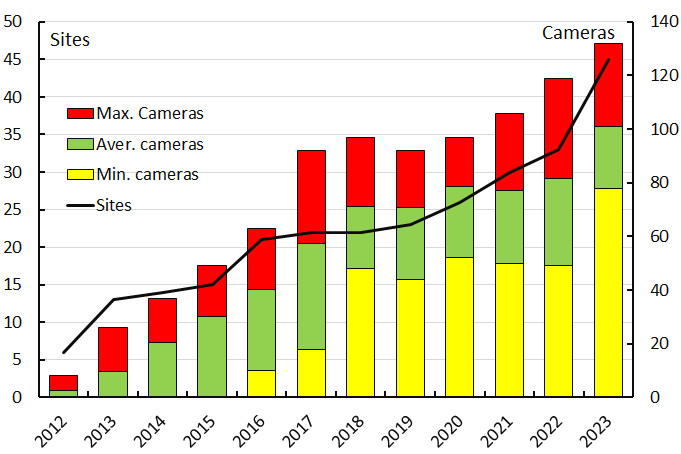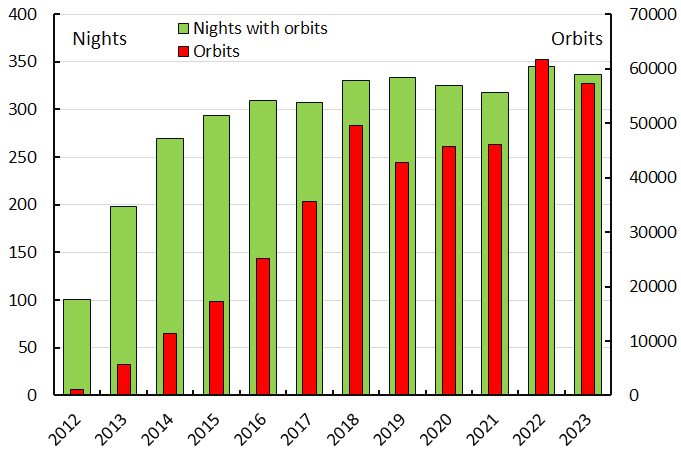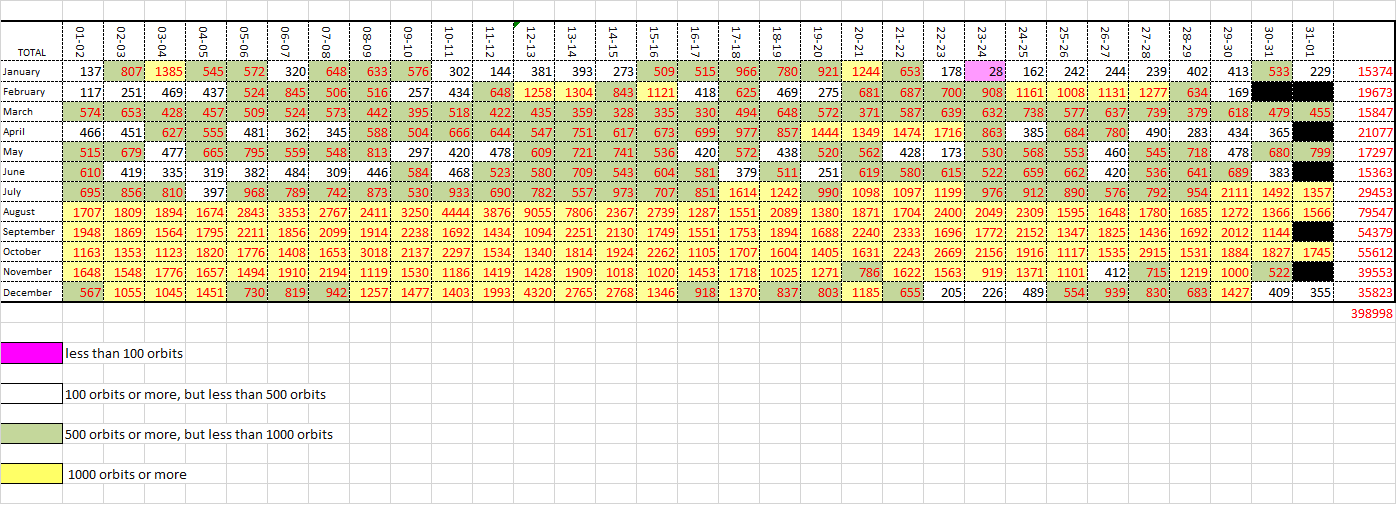Abstract: A summary of the activity of the CAMS-BeNeLux network during the year 2023 is presented. The year 2023 brought a mix of good and bad conditions for astronomical observations. The best months were especially the months June and September. In November and December on the other hand, many cloudy nights culminated in only modest results, despite the larger number of cameras involved in our network. 57190 orbits could be collected during 331 different nights which corresponds to 90,7% of all 365 nights in 2023. The months January, June, and September had the best scores ever for these months since the start of the network in 2012.
1 Introduction
In 2023, the network continued to grow steadily with new stations, especially in France and Germany. In the Netherlands three new stations, all equipped with RMS cameras, participated. Rob Smeenk added one camera at Assen and four cameras in Kalenberg. Roel Gloudemans added his camera in Alphen aan de Rijn to the network. In Germany cameras in Ludwigshafen (Eduardo Fernandez del Peloso), Solingen (Hartmut Leiting) and Osterholz-Scharmbeck, near Bremen (Horst Meyerdierks), were added. In France, Pierre-Yves Péchart in Hagnicourt, added four additional cameras to the CAMS network. Further on Stéphane Barré (Colombey-Les_Belles), Arnoud Leroy (Gretz-Armainvilliers), Jean Brunet (Fontenay le Marmion) and Tioga Gulon (Chassignolles) participated each with one RMS-camera.

Figure 1 – Sites beyond the BeNeLux countries which are participating in CAMS-BeNeLux. Future expansions between brackets.
Expansions took place mainly on the southern and eastern flanks of our network. But also, two cameras in England were added to our network, one located in Clapton, and operated by Andy Washington, and one located in Kirton and operated by Martin Richmond-Hardy. Unfortunately, Martin passed away soon after he started providing data to CAMS.
In the course of 2024, a number of sites in Germany, and also one in Denmark, have been added. Figure 1 shows all active locations outside the BeNeLux, with the locations that will participate in 2024 indicated between brackets.
2 CAMS-BeNeLux 2023 statistics
The year 2023 started with a very good result for the month of January. This was followed by four months that showed more or less an average to above-average picture.
June was a real outlier with a record harvest of orbits. No wonder: in this month we got sunshine for an average of more than 10 hours a day! July and August were very changeable, but thanks to clear nights at the right moments, they still produced great scores. After a top production in September, slowly but surely results started to decline in October. The precipitation amounts rose to record amounts, so the number of recorded meteors remained quite modest. Table 1 presents an overview of the results during each month and the annual total.
Table 1 – Results for each month in 2023 (data CAMS-BeNeLux).
| Month | Orbits | Ranking |
| January 2023 | 2291 | 1st |
| February 2023 | 3543 | 2nd |
| March 2023 | 1328 | 4th |
| April 2023 | 2888 | 3rd |
| May 2023 | 2734 | 2nd |
| June 2023 | 2889 | 1st |
| July 2023 | 3966 | 4th |
| August 2023 | 12074 | 2nd |
| September 2023 | 11331 | 1st |
| October 2023 | 7404 | 4th |
| November 2023 | 3991 | 6th |
| December 2023 | 2751 | 7th |
| 2023 (year) | 57190 | 2nd |
The months of November and December were quite gloomy, mainly for that reason this year’s total score lagged somewhat behind on 2022. Thanks to the excellent months of January, June and September, the annual total was still good for the second highest annual score with 57190 orbits, see also Table 2.

Figure 2 – The evolution of the number of cameras and camera sites, active during each year.

Figure 3 – The number of nights per year during which at least one orbit was obtained and the total number of orbits collected during each year.
Table 2 – Number of orbits collected since 2012 (data CAMS-BeNeLux).
| Year | Orbits |
| 2012 | 1079 |
| 2013 | 5684 |
| 2014 | 11288 |
| 2015 | 17259 |
| 2016 | 25187 |
| 2017 | 35591 |
| 2018 | 49627 |
| 2019 | 42746 |
| 2020 | 45743 |
| 2021 | 45985 |
| 2022 | 61619 |
| 2023 | 57190 |
| Total | 398998 |
The number of participating cameras increased by 25 during the year, but some cameras active in 2022 in the Netherlands were no longer operated. As mentioned earlier, the expansion is nearly completely due to new cameras in France and Germany. Figure 2 shows how the maximum number of different cameras that contributed orbits increased year after year. Having many cameras is good to have, but for the coverage of a camera network it is important to have as many as possible of these capturing all nights, 7 on 7. Unfortunately, due to technical and personal problems of camera operators a number of cameras is not always available. Figure 2 shows that during 2023 the average and minimum number of cameras increased thanks to the deployment of reliable fully automated systems.
Despite the rather unfavorable climate for astronomy in the BeNeLux more than 300 out of 365 nights allowed to obtain orbits since 2016 (Figure 3). The number of clear nights combined with the number of available cameras determines the chances to obtain orbits. With 345 nights with orbits 2022 was the best year ever with 2023 doing a bit less good with 337 nights. Also 2018 and 2019 were exceptional good years.
3 CAMS worldwide
CAMS is a global project in which different networks around the world participate all using the same software. Results for all networks are given in Table 3. CAMS-BeNeLux contributed to more than 11% of the total score for 2023. It remains amazing that with the well-known temperate climatic conditions we can still achieve this result in our regions.
Table 3 – Worldwide results of all CAMS networks in 2023.
| CAMS network | 2023 | 2022 | 2021 |
| LOCAMS (Arizona, USA) | 107857 | 106596 | 76232 |
| Namibia | 73960 | 81197 | 99659 |
| BeNeLux | 56741 | 61619 | 47023 |
| California (USA) | 40118 | 52130 | 39683 |
| Chile | 37606 | 49051 | 51350 |
| Australia | 59948 | 38114 | 54893 |
| UAE | 33585 | 32597 | 16294 |
| Florida (USA) | 25255 | 26454 | 24554 |
| New Zealand | 23426 | 16856 | 21661 |
| Arkansas (USA) | 12713 | 18972 | 15868 |
| Texas (USA) | 11709 | 19063 | 17449 |
| South Afrika | 7422 | 7867 | 8726 |
| Maryland (USA) | 0 | 2384 | 5140 |
| Turkey | 758 | 1605 | 1323 |
| Brazil | 29 | 105 | 144 |
| India | 0 | 0 | 0 |
| Total | 491127 | 514610 | 479999 |
When CAMS-BeNeLux started, the aim was to collect at least 100 orbits for every night of the year. Over the past 12 years, we have more than achieved this goal. Table 4 shows an overview of the number of orbits that have been collected on each calendar night of the year up to and including 31 December 2023.
Table 4 – Cumulated daily tally with the total number of orbits obtained by CAMS-BeNeLux for each calendar date, period 2012–2023.

In the meantime, we already have more than 1000 orbits available in more than 41% of the number of nights. The night 23–24 January remains ‘the outlier’ in this overview. The large harvest of orbits that we achieved in February is remarkable, despite the low meteor activity in this month. The explanation for this is that after 2014 the number of hours of sunshine in February in our regions was almost always well above normal.
Only in 2017 and 2020 did the number of hours of sunshine remain below the typical average for February. The long nights under clear sky conditions then provide such remarkable results.
Acknowledgments
Many thanks to all operators in the CAMS-BeNeLux network for their work and quick delivery of data. The CAMS-BeNeLux network was operated by the following volunteers in 2023:
Stéphane Barré (Colombey-Les-Belles, France, RMS 3907), Hans Betlem (Woold, Netherlands, Watec 3071, 3072, 3073, 3074, 3075, 3076, 3077 and 3078), Felix Bettonvil (Utrecht, Netherlands, Watec 376), Jean-Marie Biets (Wilderen, Belgium, Watec 3180, 3181, 3182 and 3183), Ludger Boergerding (Holdorf, Germany, RMS 3801), Günther Boerjan (Assenede, Belgium, RMS 3823), Martin Breukers (Hengelo, Netherlands, Watec 320, 321, 322, 323, 324, 325, 326 and 327, RMS 319, 328 and 329 ), Jean Brunet (Fontenay le Marmion, France, RMS 3911), Seppe Canonaco (Genk, RMS 3818 and 3819), Pierre de Ponthiere (Lesve, Belgium, RMS 3816 and 3826), Bart Dessoy (Zoersel, Belgium, Watec 397, 398, 804, 805, 806, 888 and RMS 3827), Tammo Jan Dijkema (Dwingeloo, Netherlands, RMS 3199), Isabelle Ansseau, Jean-Paul Dumoulin, Dominique Guiot and Christian Wanlin (Grapfontaine, Belgium, Watec 814, 815, RMS 3814, 3817, 3843, 3844 and 3845), Uwe Glässner (Langenfeld, Germany, RMS 3800), Roel Gloudemans (Alphen aan de Rijn, Netherlands, RMS 3197), Luc Gobin (Mechelen, Belgium, Watec 3890, 3891, 3892 and 3893), Tioga Gulon (Nancy, France, Watec 3900 and 3901), Tioga Gulon (Chassignolles, France, RMS 3910), Robert Haas (Alphen aan de Rijn, Netherlands, Watec 3160, 3161, 3162, 3163, 3164, 3165, 3166 and 3167), Robert Haas (Texel, Netherlands, Watec 811, 812 and 813), Kees Habraken (Kattendijke, Netherlands, RMS 3780, 3781, 3782 and 3783), Klaas Jobse (Oostkapelle, Netherlands, Watec 3030, 3031, 3032, 3033, 3034, 3035, 3036 and 3037), Carl Johannink (Gronau, Germany, Watec 3100, 3101, 3102), Reinhard Kühn (Flatzby, Germany, RMS 3802), Hervé Lamy (Dourbes, Belgium, Watec 394 and 395, RMS 3825 and 3841), Hervé Lamy (Humain, Belgium, RMS 3821 and 3828), Hervé Lamy (Ukkel, Belgium, Watec 393 and 817), Hartmut Leiting (Solingen, Germany, RMS 3806), Arnoud Leroy (Gretz-Armainvielliers, France, RMS3909), Horst Meyerdierks (Osterholz-Scharmbeck, Germany, RMS 3807), Koen Miskotte (Ermelo, Netherlands, Watec 3051, 3052, 3053 and 3054), Pierre-Yves Péchart (Hagnicourt, France, RMS 3902, 3903, 3904, 3905, 3906 and 3908), Eduardo Fernandez del Peloso (Ludwigshafen, Germany, RMS 3805), Tim Polfliet (Gent, Belgium, Watec 396, RMS 3820 and 3840), Steve Rau (Oostende, Belgium, RMS 3822), Steve Rau (Zillebeke, Belgium, Watec 3850 and 3852, RMS 3851 and 3853), Martin Richmond-Hardy (Kirton, England, RMS 3701), Paul and Adriana Roggemans (Mechelen, Belgium, RMS 3830 and 3831, Watec 3832, 3833, 3834, 3835, 3836 and 3837), Jim Rowe (Eastbourne, England, RMS 3703), Philippe Schaack (Roodt-sur-Syre, Luxemburg, RMS 3952), Hans Schremmer (Niederkruechten, Germany, Watec 803), Rob Smeenk (Assen, Netherlands, RMS 3196), Rob Smeenk (Kalenberg, Netherlands, RMS 3192, 3193, 3194 and 3195), Jan Thoemel (Luxembourg, Watec 3950), Erwin van Ballegoij (Heesh, Netherlands Watec 3148 and 3149), Stef Vancampenhout (Vorselaar, Belgium, RMS 3842), Andy Washington (Clapton, England, RMS 3702).

